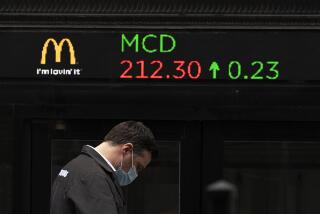SEC Tax Rules Will Require Funds to Disclose Worst-Case Returns
- Share via
The mutual fund industry doesn’t mind disclosing how funds perform after taxes, though new rules will make most investors think Uncle Sam’s cut is bigger than it really is, an industry official said.
Rules approved by the Securities and Exchange Commission last month will require mutual funds to disclose for the first time how the taxes that investors ultimately pay on fund dividends and capital gains affect their returns.
Although the Investment Co. Institute, the fund industry’s Washington-based trade group, supports disclosure, the SEC uses the highest tax bracket to compute taxes, ICI President Matthew P. Fink said. Most fund investors either fall into a lower bracket or are invested in funds through tax-deferred plans such as 401(k)s and individual retirement accounts, he said.
“Only 1%, a very small minority of mutual fund shareholders, are in the highest 39.6% tax bracket,” Fink said.
The tax information will not only mislead fund investors, it will also give less well-regulated competitors an unfair edge, he said.
“Competitors who don’t have to show any of this can say, ‘Gee, look how you get whacked in mutual funds,’ ” Fink said.
The SEC rules compound the problem by applying the short-term capital gains rate to funds’ one-year total returns, Fink said. Though short-term rates would apply to investments held for exactly a year, most shareholders know the value of waiting more than a year to redeem shares. After a year, gains are taxed at the long-term rate, which is lower.
“Most shareholders with their heads screwed on right will not redeem on the 365th day,” Fink said. “[They’ll] wait one more day and pick up a huge rate advantage.”
The new rules also require that the after-tax information be included in the risk/return summary section of a fund’s prospectus, rather than the tax disclosure section. That makes explaining the information--including that the assumed tax rate may differ from the shareholder’s--more difficult, Fink said.
Paul Roye, director of the SEC’s division of investment management, said the SEC placed the after-tax return numbers right next to the pretax return numbers at the front of the prospectus.
“That’s where investors can be expected to pay attention to it, not back in the tax section where they may not pay attention to it,” Roye said.
As for using the highest tax rate, Roye said the decision was one the SEC wrestled with. Still, after-tax performance numbers are just meant as a barometer of a fund’s tax efficiency and aren’t designed to tell anyone what their individual rate is. Using the highest rate covers everyone by providing a worst-case scenario.
If the SEC tried to show how each investor would be affected by taxes, “we’d have to have a tax table in the prospectus,” Roye said.
The rules are expected to take effect in about a year, he said.
More to Read
Inside the business of entertainment
The Wide Shot brings you news, analysis and insights on everything from streaming wars to production — and what it all means for the future.
You may occasionally receive promotional content from the Los Angeles Times.










